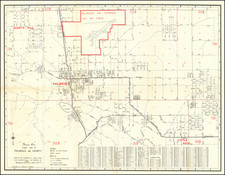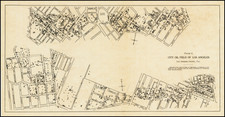Thomas Bros. Street Map of Palmdale and Vicinity [on sheet with:] Thomas Bros. Map of Antelope Valley, published by Camille E. Thomas in Los Angeles around 1950, offers a discerning representation of the Palmdale region and its broader environs. The map notably delineates crucial landmarks such as the air force bases at Palmdale and Edwards, shedding light on the significant military presence in the region during the mid-20th century.
Situated in the midst of the Cold War, the 1950s witnessed a surge in U.S. military installations and activities, and the air force bases at Palmdale and Edwards are emblematic of this era. These bases played pivotal roles in the development and testing of aviation technologies, serving as a testament to the region's critical contribution to national defense and aerospace advancements.
This map's legend highlights the U.S. & State Highways that connected the region to the rest of California and the nation, and demarcates schools, parks, and railroads; the map serves as a comprehensive guide to both the urban and rural characteristics of Palmdale and Antelope Valley. The inclusion of range & township lines and section corners suggests a detailed focus on land ownership and divisions, reflecting the region's changing dynamics in terms of property and development.
Furthermore, the acknowledgment of the map's provision by the Palmdale Chamber of Commerce underscores the civic pride and investment in promoting the region's assets and offerings. This act of civic endorsement showcases the intertwining of economic, social, and cultural aspirations of the community, which aimed at representing Palmdale and Antelope Valley as both a strategic military hub and a burgeoning locality.
Thomas Brothers and Their Legacy in Mapping
The Thomas Brothers, pioneering cartographers of the 20th century, carved a unique niche in the world of mapmaking with their meticulous street atlases that have since become indispensable resources for countless Americans. The trio's journey began in the bustling hub of Oakland, California, in 1915, where George Coupland Thomas and his two brothers established Thomas Bros. Maps.
Initially, their publications included detailed block maps, birds-eye views of communities, and what one might consider generalized tourist maps. Their emphasis on accuracy, granularity, and user-friendliness quickly set them apart in the growing map industry. By the late 1940s, the brothers expanded their offerings, introducing street guides initially available as pocket-sized booklets. These guides encapsulated regions across several counties in California and even extended to Washington, offering detailed street views and points of interest.
A significant historical footnote is the company's involvement in producing redlining maps for several major Californian cities like Los Angeles, San Francisco, and Sacramento for the US government-sponsored Home Owners' Loan Corporation in the 1930s. These maps, controversial in today's context, played a role in shaping urban development and housing policies of the time.
In 1940, seeking larger opportunities and driven by the company's burgeoning success, the Thomas Brothers relocated their headquarters to Los Angeles. The move coincided with the addition of pocket-sized guidebooks dedicated to California and San Francisco, complete with fold-out maps, further solidifying their dominance in the local market.
Following the death of George Coupland Thomas in 1955, the company witnessed a transition in leadership. Warren B. Wilson, the family lawyer, acquired the business. Under his guidance, Thomas Bros. Maps continued to flourish, adapting to the changing needs of the market and expanding its geographic footprint.
By the onset of the California home development boom in the 1970s, the company's reputation was unparalleled. The transition to Irvine, California, in 1980 under Wilson's directive marked a new era, with the company setting its sights on digital innovations and new markets.











![(Early Hollywood Photography) [Studio of R.A. Whitten]](https://storage.googleapis.com/raremaps/img/small/97888.jpg)


![Air Log Western Air Express [Los Angeles-San Diego, Las Vegas-Los Angeles, Milford-Vegas, Salt Lake City-Milford]](https://storage.googleapis.com/raremaps/img/small/85953.jpg)

